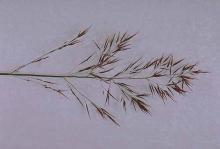Cause Several species of the nematode genus Anguina can affect orchardgrass, annual ryegrass, bentgrass, and fescue. Recent DNA studies point to the likelihood of a different Anguina species evolving on each susceptible grass genus. These studies also suggest that Anguina agrostis may be limited to infecting only bentgrass. DNA testing can be used to identify the Anguina nematodes to species.
Anguina is believed to infect orchardgrass during the wet conditions (winter through spring in the Willamette Valley). Juveniles emerge from the gall after the gall wall has degraded or broken, migrate to orchardgrass plants, and invade the base of tillers. The nematodes induce small galls within the base of tillers, where they differentiate into males and females and lay eggs. Juveniles hatch from the eggs and migrate from the basal galls to the developing panicle to infect ovaries. By the time panicles emerge in the spring, galls have already been initiated, and conspicuous seed galls may form. Infected seeds contain many hundreds to several thousand juveniles that will serve as next year's inoculum source. Disease usually increases slowly over time and often occurs in localized areas of the field. Yield loss can become quite significant in bentgrass or annual ryegrass fields and occasionally in fescue fields, but in most cases it is primarily a phytosanitary issue.
These nematodes have also been shown to serve as phoretic hosts for Rathayibacter rathayi (see Grass for Seed - Rathay's Disease). Under certain conditions, this bacterium and related species can produce glycoproteins that are neurotoxic to livestock. Consumption of seed screenings with high levels of these glycoproteins has been reported to produce sheep staggers in the Pacific Northwest and Australia.
Symptoms In bentgrass, infected seeds form large, spike-shape black galls, three to ten or more times longer than healthy seed. Numerous galls in a seed head gives the floret an irregular appearance. In annual ryegrass, infected seeds form black, spike-shaped galls that are the same size or slightly smaller than healthy seed. Fescue galls are very difficult to detect in the field. Infected orchardgrass seeds are nearly asymptomatic; galls are rarely reported though orchardgrass plants may be stunted.
Sampling Juveniles can be readily extracted from harvested seed by laboratory testing but are difficult to detect before seed matures.
Cultural control
- Use only Anguina-free seed to establish new plantings of orchardgrass, bentgrass, and fescue.
- Seed galls can be easily transported on equipment, shoes, and pant cuffs, etc. Practice proper sanitation.
- Because the host range is limited, grass-free rotation for 1 year will greatly reduce or eliminate seed gall nematodes from grass seed fields.
- Mow to prevent seed head formation.
- Reduce the return of galls back to seed fields by removing lightweight seed after seed is harvested from field (during subsequent cleaning).
- Open field burning reduces the number of galls within residues exposed to fire, but galls that fall within the crowns or are covered by soil will likely escape the high temperatures required to kill nematodes. Open burning to control Anguina should be as soon as possible after harvest. Propane burning may not be effective since temperatures may not be high enough to kill Anguina.

